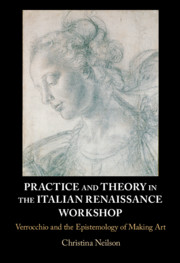 Practice and Theory in the Italian Renaissance Workshop
Practice and Theory in the Italian Renaissance Workshop Published online by Cambridge University Press: 06 July 2019
This chapter explores how Verrocchio used techniques and materials in his Christ and Saint Thomas to represent visually Thomas’ revelation of Christ’s material state after the Resurrection as absent presence. Made from bronze (by an artist who touched his material only indirectly) and as shallow reliefs, the sculpture shows through its material facture Thomas’ revelation. The bronze makes Christ physically present but the wax that the artist touched and from which the sculpture was made is materially absent; similarly, although the sculptures appear to be solid sculptures made in the round, they are only shallow reliefs, their physical forms serving as metaphors for the idea of absent presence.
To save this book to your Kindle, first ensure no-reply@cambridge.org is added to your Approved Personal Document E-mail List under your Personal Document Settings on the Manage Your Content and Devices page of your Amazon account. Then enter the ‘name’ part of your Kindle email address below. Find out more about saving to your Kindle.
Note you can select to save to either the @free.kindle.com or @kindle.com variations. ‘@free.kindle.com’ emails are free but can only be saved to your device when it is connected to wi-fi. ‘@kindle.com’ emails can be delivered even when you are not connected to wi-fi, but note that service fees apply.
Find out more about the Kindle Personal Document Service.
To save content items to your account, please confirm that you agree to abide by our usage policies. If this is the first time you use this feature, you will be asked to authorise Cambridge Core to connect with your account. Find out more about saving content to Dropbox.
To save content items to your account, please confirm that you agree to abide by our usage policies. If this is the first time you use this feature, you will be asked to authorise Cambridge Core to connect with your account. Find out more about saving content to Google Drive.